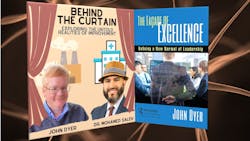Podcast: The Facade of Excellence: Unveiling Leadership’s Emotional Journey
Have you ever looked back on your career and thought, "I should write a book." Continuous improvement expert John Dyer did more than think about it. His book, "The Facade of Excellence: Defining a New Normal of Leadership," tells the tale of good leadership, bad management, and the necessary ingredients to build a culture of continuous improvement and collaboration. It pulls from Dyer's own experiences and in a fiction format shares the change management efforts within a mythical manufacturing company. One small hint: It was not smooth sailing.
In this episode of Behind the Curtain: Adventures in Continuous Improvement, podcast co-host Dyer shares the experience of recording the audio version of The Façade of Excellence, and he and co-host Mohamed Saleh highlight leadership lessons from key scenes in the story. They include:
The introduction of Jim Brown, a new vice president at the company. He is fairly young and early in his career and wants to make improvements the right way. In the very first scene, Brown meets the security guard, Joe, in the company parking lot, which is dark because many of the lights are burned out. Joe’s equipment doesn’t work either. Jim’s takeaways: The company doesn’t care much about the safety of their employees—or their employees at all. Jim immediately leaps into action to personally improve Joe’s working conditions, showing both respect for people and servant leadership.
A crisis hits and team improvement efforts are halted temporarily. Jim fears this event could hurt progress that has been made in building trust, growing employee engagement and making improvements. In an all-employee meeting, Jim shares the crisis and assures employees that training and improvement efforts will resume in one month. Moreover, employees assure Jim they are willing to work the extra hours needed to help with the crisis.
“That's a real tipping point in the book,” Dyer notes. “All this time, Jim has been trying to get [employees] on board, trying to change the culture. And when this crisis hits, and the employees respond the way they do in the book, it just affirms that they are getting there, that they're reaching that point of collaboration and teamwork.”
Saleh points out two important concepts in this exchange between Jim and the employees: The vice president is transparent about the problem, and he gave the workforce a timeline by which they would exit crisis mode. Many times, companies revert to crisis mode and “they stay there forever,” he says.
Saleh also noted that the workforce rallied around Jim because he had already built trust. Absent that trust, their willingness to help Jim is doubtful.
Events take a turn, and the lean efforts come crashing down. Old-style command and control leadership returns. Among the casualties is Mary, a production worker who initially resisted efforts and over time became a champion of change.
About the audio recording process, Dyer says: “These characters are based on real life people, and in three different times, as I'm reading it, I got choked up … [at] one point I had literally tears in my eyes.”
“When you're trying to change the culture, you’ve got to build relationships with people.”
